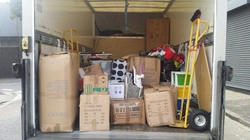
Office Removals: A Comprehensive Guide to Streamlined Corporate Relocations
In today's fast‐paced corporate world, the process of moving your business operations from one location to another is more than a mere logistical change—it's an art and a science. Office removals, also known as corporate relocations or commercial moves, have evolved into a specialized industry focused on ensuring that businesses transition smoothly with minimal interruption. Organizations seeking to relocate their offices are faced with a unique challenge: how to maintain uninterrupted business productivity while managing the intricacies of moving equipment, sensitive documents, and valued relationships. The modern office removal process is rigorous and meticulous, demanding detailed planning, expert handling, and robust communication strategies. With an increasing number of businesses expanding operations or relocating to take advantage of better facilities, newer technological innovations, or cost efficiencies, the need for professional office transfer solutions is greater than ever. This comprehensive article explores every facet of the office removals industry, revealing key insights, strategies, and advice that will serve both small enterprises and large corporations alike.Understanding the Criticality of Professional Office Relocations
When companies relocate, the risks involved are not just physical but also strategic—data loss, downtime, and even damaged reputations can result from poorly executed moves. In many cases, employing professional teams who specialize in office removals can translate into significant long-term savings and improved employee satisfaction. The underlying objective is simple: to shield the business from unnecessary disruptions. Engaging experts in commercial removals means leveraging industry best practices, expert logistics planning, and cutting-edge technology to protect your brand and assets. Many organizations invest in specialized moving equipment, dynamic tracking systems, and dedicated project management teams to handle these complex tasks efficiently. Corporate moves are unique; they require an utmost level of precision and a tailored approach that considers each business's specific infrastructure and requirements. Within this landscape, the planning process begins long before the moving day, with comprehensive audits, scheduling of downtime, and meticulous inventory management. This phase sets the stage for a seamless transformation of your operational hub and acts as a foundation for future growth. Every detail matters, from labeling systems and packing protocols to secure transport and unpacking methods.
Key Strategies for Seamless Commercial Moves
For organizations aiming to perfect the art of office relocations, several strategies can be embraced to ensure efficiency and safety. One method involves breaking down the project into manageable tasks and setting clear deadlines. A few of the most effective strategies include:The Planning Phase: Laying the Foundation for Success
The journey toward a successful office removal commences with robust planning and preparation. This stage encompasses everything from assessing the current office layout to projecting future space requirements, securing necessary permits, and understanding the legal prerequisites in various regions. Businesses are advised to enlist the help of a professional planner who can evaluate all moving parts in a comprehensive manner. An effective office relocation strategy entails performing a risk assessment, mapping out a timeline, and establishing contingency plans for potential disruptions. A clear communication plan must also be implemented to keep employees, stakeholders, and vendors informed at every stage. In addition, investing in modern relocation tools and software can forecast challenges, streamline operations, and monitor progress in real time. This strategic approach not only mitigates risk but also fosters a culture of preparedness that can be invaluable during unforeseen events. As companies expand into new markets or update office environments to keep pace with technological advancements, the importance of detailed logistical planning is underlined by both its complexity and its potential rewards.
Innovative Tactics and Technological Advances in Office Transfers
As the scope of commercial removals expands, innovative approaches have begun to dominate the industry. One such tactic is the integration of digital tracking systems which offer comprehensive monitoring of assets throughout the move. For instance, radio-frequency identification (RFID) tags and barcoding of office equipment ensure that nothing falls through the cracks during transit. Moreover, software solutions that allow project managers to track progress and reallocate resources in real time are revolutionizing the way businesses approach the moving process. This digital transformation has not only increased the efficiency of office relocations but has also introduced heightened transparency between the service providers and the clients. Office relocation specialists are now able to offer precise estimates and detailed reports that guide decision-makers in real time. The enhanced level of communication reassures stakeholders and builds a bridge between planning and execution. Additionally, modern mobile applications provide employees with access to moving schedules, packing guidelines, and even instant support, making the entire relocation process more interactive and less stressful. By embracing these technological advances, companies are empowered to adapt swiftly to new working environments while minimizing downtime and disruption. The fusion of creativity and technology in office removals ensures that every critical element—from data management to physical moving processes—is approached with modern efficiency and reliability.Execution and On-Site Coordination: Achieving a Flawless Transition
Every meticulously planned phase converges during the actual execution of the move. The execution stage is where strategies are put to the test, and the efficiency of the entire process gets validated. In this phase, on-site coordination becomes critical, ensuring that all elements of the move are synchronized from start to finish. An effective commercial removal strategy encompasses precise scheduling, thorough communication between teams, and predefined roles for every team member. The physical process of moving high-value office equipment—such as servers, computers, and specialized machinery—demands careful handling, proper packing, and advanced security measures. Specialized logistic teams with expertise in handling sensitive technology provide a safeguard against potential hazards. The teams often employ a variety of protective materials, from cushioned padding to custom crates, to mitigate damage risks during transportation. Additionally, clear signage and labeling within the new office space facilitate the smooth setup of workstations and critical infrastructure. This phase is particularly significant because timely problem-solving during onsite execution can help avoid setbacks that might impact business continuity. Engaging experts in every step of the process helps in reducing unnecessary stress, creating a seamless transition, and enabling business operations to resume with minimal delay. Emphasizing team coordination and precise execution is not only the essential backbone of any successful office relocation but also a testament to the evolving sophistication in commercial removals.Post-Move Support and Business Continuity
After the physical shift is complete, the post-move phase plays an equally crucial role in cementing the successful relocation of an organization. This phase involves the re-establishment of IT systems, reconfiguration of workspaces, and ensuring that employees are well-adapted to the new settings. Companies must work proactively to solve any lingering issues, such as connectivity problems, misaligned office layouts, or displaced equipment. Post-move support includes setting up dedicated help desks, offering employee training sessions on new office layouts, and generating a feedback loop that helps address and resolve unforeseen complications promptly. Often, these post-move adjustments require swift action to keep the momentum going and minimize operational hiccups. Organizations that invest in comprehensive post-move support demonstrate their commitment to business continuity and the well-being of their workforce. This approach not only accelerates the settling-in process but also enhances overall operational resilience. It is a testament to the thoroughness and professionalism that characterizes modern office removals. Recognizing that every minute counts in today’s competitive market, expert relocation teams incorporate post-move support as an integral part of their service offerings, ensuring that businesses can hit the ground running without a hitch.
Cost Considerations and Financial Efficiency in Corporate Moves
The economics of office removals are a significant concern for every organization considering relocation. Financial oversight is crucial, from managing direct moving costs to budgeting for unforeseen contingencies that can arise during the move. Businesses must evaluate various cost components such as packing materials, labor charges, insurance premiums, and even the potential loss of productivity due to downtime. A detailed and realistic cost analysis is beneficial in outlining all necessary expenditures and avoiding budget overruns. Many companies have found that hiring a professional moving firm, although seemingly expensive at first glance, can end up saving money in the long term by reducing risks and ensuring rapid re-establishment of operations. Some expert relocation providers even offer bundled services that include both the move and subsequent setup, providing an all-inclusive package aimed at financial efficiency. Moreover, companies should consider negotiating fixed-price contracts to maintain greater control over expenses, a strategy that has proven effective for many enterprises. Careful financial planning and strategic resource allocation are not just about cutting costs—they are about optimizing the overall business structure during and after the move. Detailed planning combined with expert execution ensures that each stage of the process contributes towards not only smoother transitions but also improved long-term economic stability for the organization.


